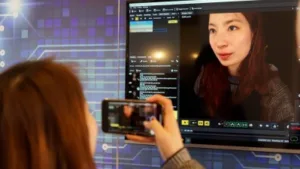Mantis Vision was showing a professional system for facial scanning that creates high quality avatars or images for use in access control systems. The images took a couple of minutes to produce, but were very detailed and realistic. They are created using three scanning sensor setups to capture different directions.
![]() The Mantis Vision scanner can create very, very lifelike avatars. Image:Meko
The Mantis Vision scanner can create very, very lifelike avatars. Image:Meko
Neotion is one of the companies that we regularly see at IBC. At MWC, it was showing its OTT over satellite solution, which is now rolling out with its OTT over DVB-S2 solution with Tricolor. The company uses statistical multiplexing to combine up to 50 channels of video into a single stream which it transmits as a single IP stream over DVB using a single transponder. This can be used as a backhaul to deliver video very economically to distribution points. Latency is very low and a single box can support all the channels with up to 50 devices as they are doing the decoding. A single channel can be transmitted in just 100kbps, so the system is usable even where there is no 4G support, allowing video over 3G.
Neotion is also supporting locations such as shopping malls, bars and waiting rooms where up to 50 individual video streams can be supported very cost effectively. It is also rolling out the solution over wider geographies including Asia and Africa.
The company has its own client for Android and iOS that can ‘zap with a swipe’ and which can be customised to support specific branding. It works on Android or iOS devices and can support any DRM scheme for secure and Pay TV content.
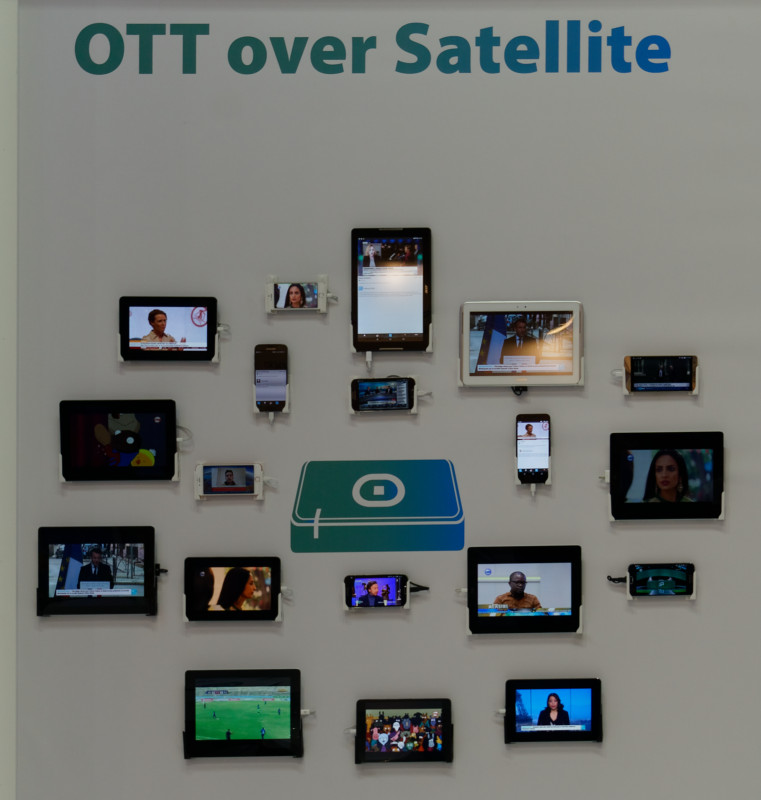 Neotion can deliver 50 OTT streams via a single satellite transponder. Image:Meko
Neotion can deliver 50 OTT streams via a single satellite transponder. Image:Meko
NTT Docomo had an autonomous vehicle that it has developed with Sony and which includes a large display at the front, rather than a window. The company was also showing its AW3D world mapping project which is ‘deep stacking’ images from satellite and is intended to build into a 3D model of the world with 5m of resolution.
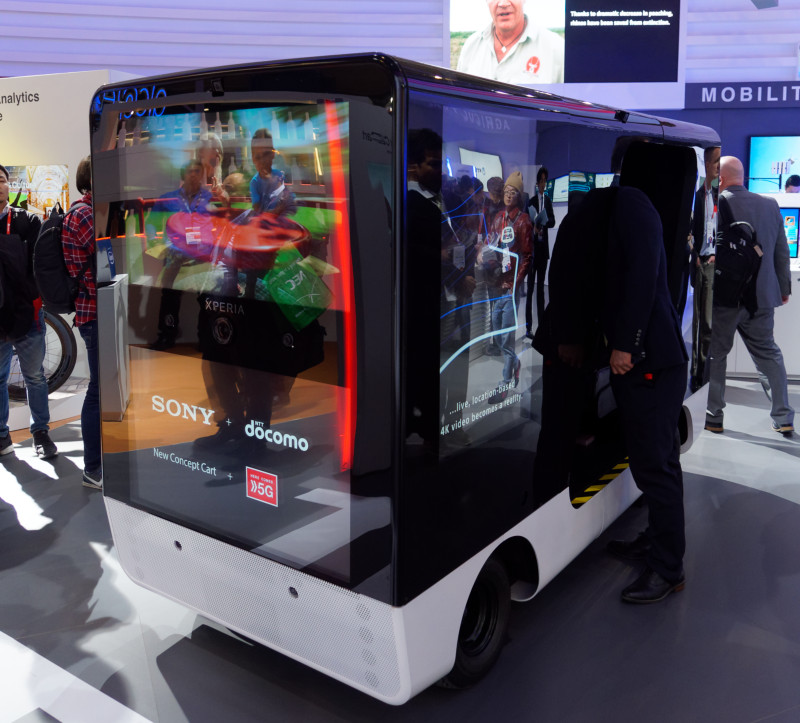 NTT Docomo showed this autonomous car, developed with Sony. Image:Meko
NTT Docomo showed this autonomous car, developed with Sony. Image:Meko
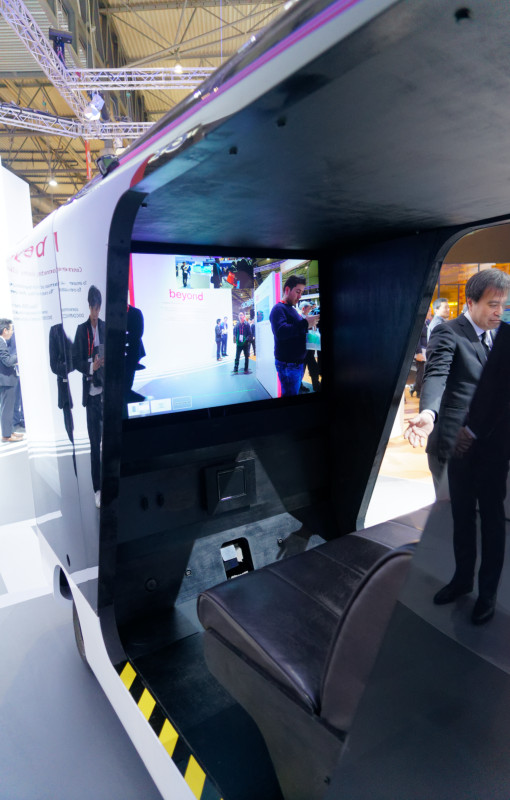 Inside the NTT Docomo autonomous car, there was a big display rather than a window on the front. Image:Meko
Inside the NTT Docomo autonomous car, there was a big display rather than a window on the front. Image:Meko
Optofidelity is a company that we haven’t reported on and the firm was showing its VR Tester. The system uses a special proprietary camera to capture and measure the response and lag in VR headsets. The system can also be programmed with special motions to check for artefacts and inconsistencies. The camera can cope with waveguide-based systems such as those from Daqri and Lumus and has a patented synchronisation system that means that data can be directly used without post-processing.
 Optofidelity’s head system can measure motion in VR & AR headsets and track latency. Image:Meko
Optofidelity’s head system can measure motion in VR & AR headsets and track latency. Image:Meko
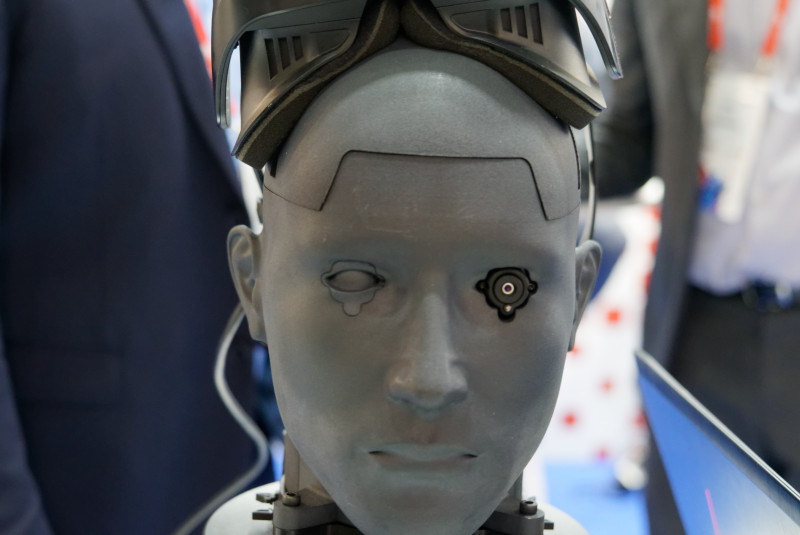 Optofidelity’s special camera which tracks VR and AR very accurately. Click to see the kind of data produced Image:Meko
Optofidelity’s special camera which tracks VR and AR very accurately. Click to see the kind of data produced Image:Meko
Osram had a booth to talk to buyers of its technologies. As a component supplier it was, as always, cautious about what it said. However, we learned some things. The company had a range of infrared LEDs and detectors that are used for a range of applications. There are a range of different infrared LEDs used for gaze tracking. One reason for a range of options is that there is a considerable range of types of eye, globally, with Asian eyes often quite different from Caucasian eyes. That can mean that different wavelengths of LEDs and detectors may be needed.
Applications for gaze tracking include automotive and Osram has products that are optimised for this particular application.
![]() Osram has a range of LED options for gaze tracking. Image:Meko
Osram has a range of LED options for gaze tracking. Image:Meko
60GHz and Wigig developer, Peraso, was at the show to talk about the use of its 60GHz technology in backhaul applications, but also as a technology for wireless VR headsets. The company has a reference design for 60GHz headsets.
RealD Me was showing some cool technology, which it calls ‘Social Eyes’ which is able to modify the eyes in a captured video conference image and adjust the eyes to make it look as though the remote person is looking directly at the camera. The effect was both subtle and very important – I thought it worked really well and wouldn’t hesitate to use it myself. The processing can be done at the remote end or locally, when transmitting or receiving. The company is in discussions with device makers.
The company also had True Face, a technology for 3D mesh generation that can be used to create avatar faces, without the need for infrared depth data. The avatar can then be animated in real time to match the subject.
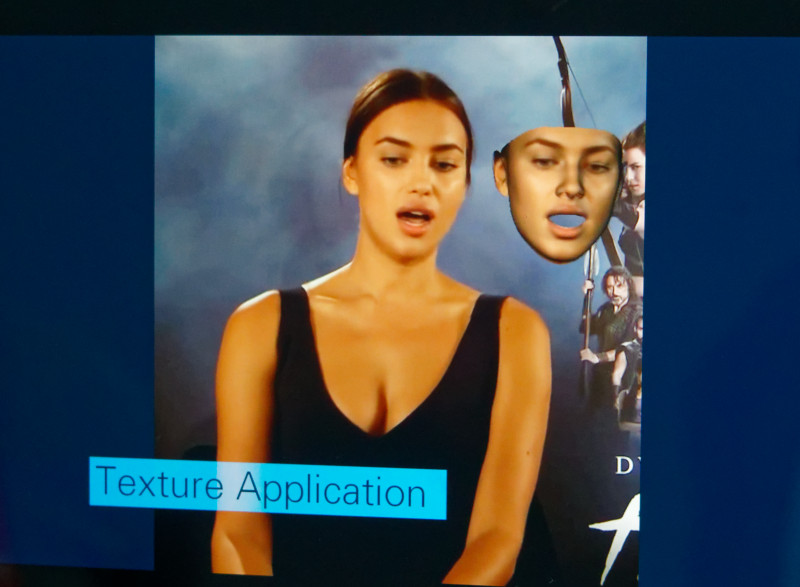 RealD Me has True Face software for Avatar creation and animation. Image:Meko
RealD Me has True Face software for Avatar creation and animation. Image:Meko
It was no suprise to see Reticare at MWC as the company is based in Spain and works with the University of Barcelona. The company told us that it has seen a lot of interest in the issue of the damage from blue light as there is an ‘epidemic’ of sight problems, especially among young people, in Asia. The firm also told us that there is new research on rats that shows significant damage to the retinas when exposed to blue light. We were promised that we would be sent the new data, but so far, we haven’t seen it. We also bumped into TÜV Rheinland and asked them what their ‘low blue light’ testing meant. Again, they have promised to get back to us, but the secret society of TÜV seems to be running true to form.
SK Telecom always has a range of topics on its booth, although we spotted less that was display-related this year, we think. There was a 5G tablet that was showing how 5G has the bandwidth to be able to be used to stream 360º video.
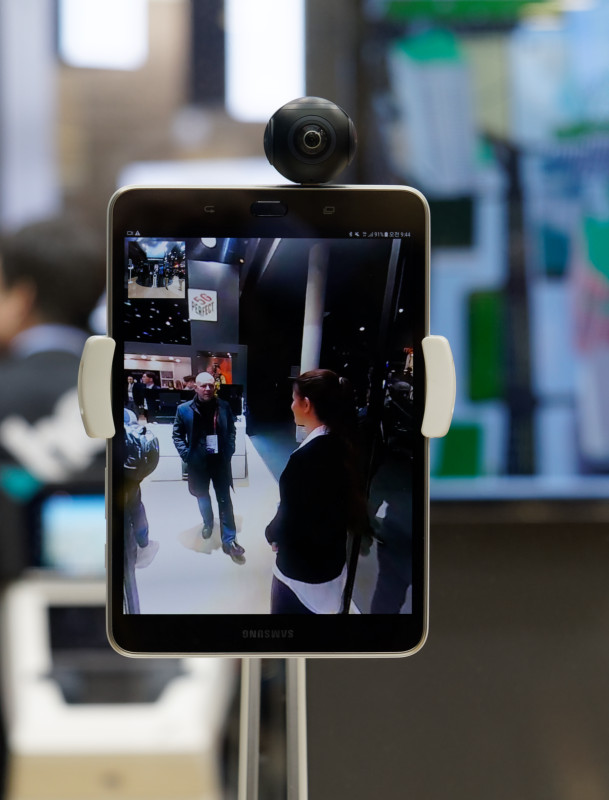 SK Telecom had a ‘5G Tablet’
SK Telecom had a ‘5G Tablet’
The Holobox is a 365mm height device which is a demonstration of a smart speaker that includes a ‘hologram’ for video conferencing. The Holobox is designed to work on 5G and the control is via a smartphone. The avatar in the Holobox is of Korean pop star, ‘Red Velvet Wendy’, and the box uses a UST projector internally for the image although we couldn’t get technical details at the event as this was a ‘tech demo’ rather than a product launch.
 SK Telecom’s Holobox replaces Alexa and Siri with a Wendy avatar. Image:Meko
SK Telecom’s Holobox replaces Alexa and Siri with a Wendy avatar. Image:Meko
ST Microelectronics was concentrating on MEMs devices and time of flight sensors at the show, but it also had an area devoted to touch, although no specialist staff were available when we went by. The company was highlighting its latest touch controllers, which can support operation with gloves, with water on the surface or with some ‘hover’ functions.
Streem was at Showstoppers with its AR application which is built on Google’s ARCore. The company has engineers that came from professional AR and they are looking to extend the concept to the consumer market. The app supports one way video and two way audio with some AR functions and even some approximate measurement facilities.
The aim is, for example, for a repair or estimate for work, a consumer could use the app to show a site or problem to a professional tradesman, such as a plumber or kitchen fitter, who can guide the user and capture images from the app, including measurements. The measurements are not especially accurate, but ‘in the ballpark’. It works with any mainstream smartphones. The app allows a professional to add an arrow to the remote display, which stays fixed on the remote scene, so the consumer can be directed to show more detail or take more pictures.
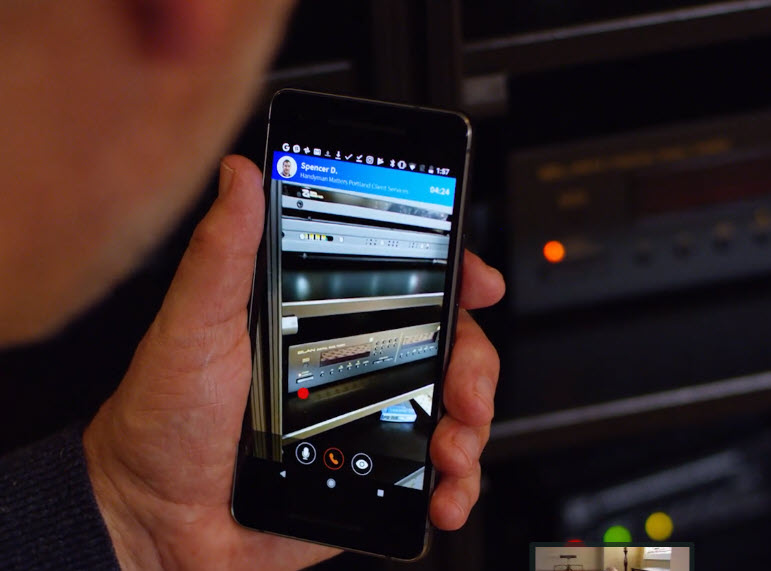 Streem can be used for support – the red dot is directing the user to look at a control on the unit.
Streem can be used for support – the red dot is directing the user to look at a control on the unit.
Swan Electronicsis from Korea and was one of the small number of interesting companies at the 4YFN event at the old fairground. The company was showing transparent LCDs in a showcase application, with infrared touch. The company told us that it has object recognition technology that could make the showcases easier to use as the showcase could automatically recognise an object that was put in the case and put the correct video and data on the touch screen, without any IT work by staff. This is helpful in retail applications.
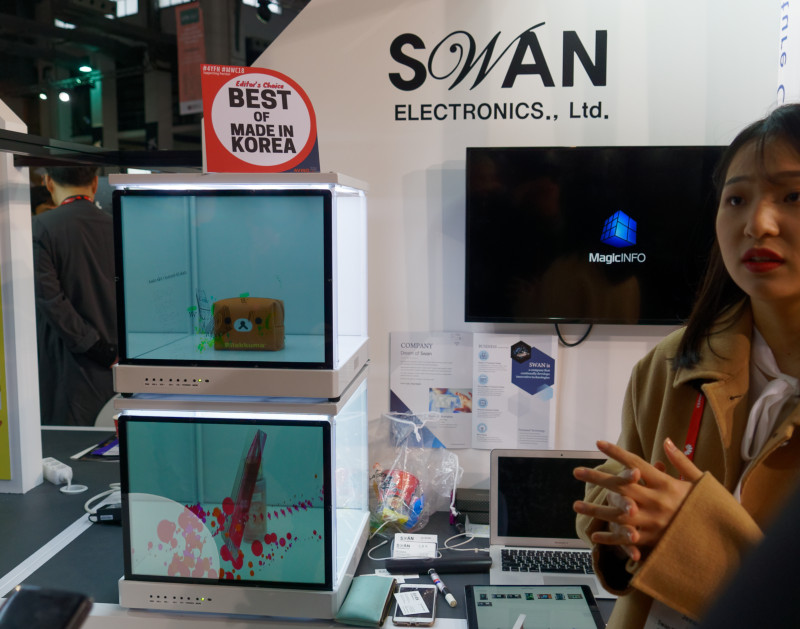 Swan Electronics was showing its ‘intelligent’ showcases. Image:Meko
Swan Electronics was showing its ‘intelligent’ showcases. Image:Meko
Theia of Taiwan was showing its 3D autostereoscopic technology which is based on a lenticular design and is implemented on the Apple iPhone 7, 8 and X. The company plans to add other support later and the company told us that the add-on costs $40, including access to the conversion process. The company has a process for 2D to 3D conversion that is fully automated and can be run on images locally or in the cloud. The process can run on photos captured on the phones (main cameras on all three phones, but only the X for selfies).
THX was making lots of noise about its spatial audio technology and the company was keen to highlight that its technology covers the whole chain from capture and production through transmission and rendering. The company also told us that good, object-related audio can often have a lower need for bandwidth than sending rendered high quality audio. The company’s audio streams can be encoded and transmitted using the MPEG-H standard. The rendering can be supported on a range of processing devices from DSPs to PCs. In mobile, new devices such as the Snapdragon 645 have a huge amount of available power for processing.
THX has done a lot of work on pyscho acoustics to understand how the ear and the brain are used to give direction and clarity to audio, based on tiny timing and frequency shifts. Although you can make quite a good job using a ‘standard ear’, it is better to get optimisation done to match the individual ear, which can vary a lot. THX has developed an AI and cloud-based system using which, the user can upload an image of the ear and the system can create a set-up that is optimised individually. The optimisation can be supported not only for object-based audio, but also for existing formats such as 5.1 or 7.1 audio.
As well as general improvements in the quality of audio, the company can process audio to improve the clarity of dialogue.
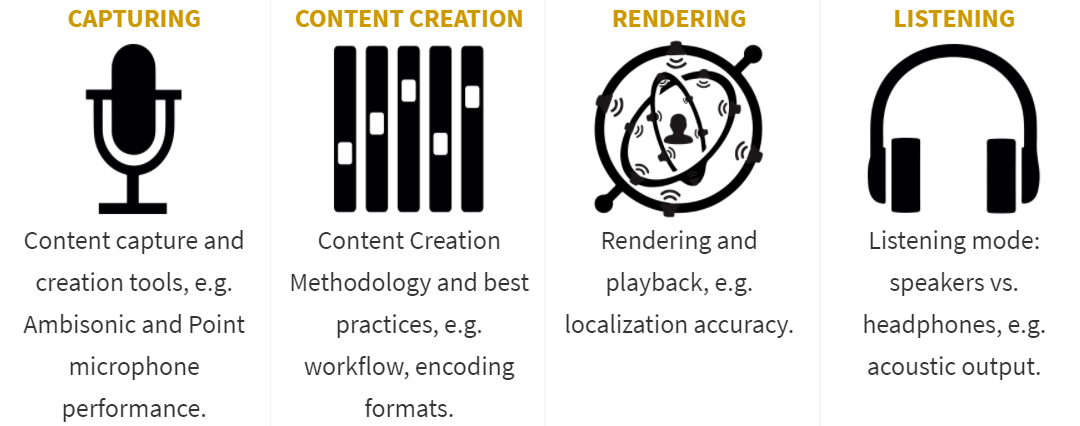
The UHD Alliance was on the Fraunhofer booth and was there to promote its campaign on its UltraHD logo programme. There has not been a huge change since the update at IFA although Google and Synapics have both joined the alliance, now.
We asked about support for HLG (the current spec is based on PQ) and were told that although there is a big push to ensure support HDR. The Alliance members at the event didn’t seem particularly aware of HLG, but this is a US initiative backed by, among others, the studios, so that’s not really surprising. At MWC, there was a small demo of HDR on a Samsung Note 8 phone – it did look very good.
The organisation is working on getting more adoption of the ‘Distribution’ specification – at the moment, the only platform with support for the logo is Blu-ray. It is also developing its support for users and has created five videos and had a ‘soft launch’ in October. It is working on extending the language support for its consumer aid content.
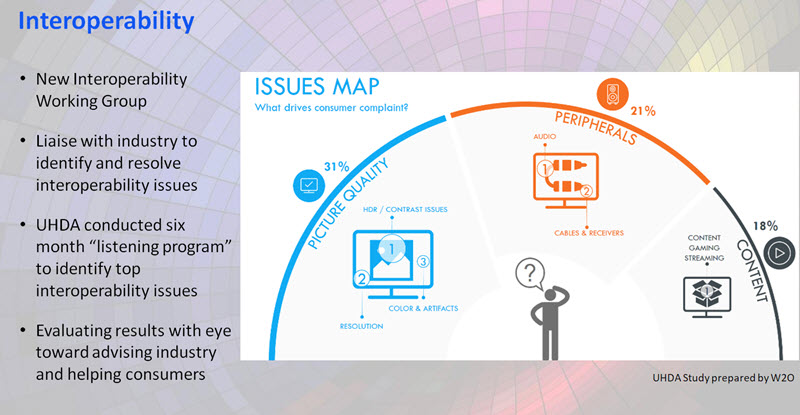 The UHD Alliance is still working on this “Issues Map”
The UHD Alliance is still working on this “Issues Map”
Vestel had its usual big stand that was devoted to showing the range of Android-based smartphones that it is currently producing for sale under its own brand in Turkey and in markets where it has established channels, locally. Despite its strengths in electronics assembly, Vestel is finding the market tough when competing with major Chinese handset makers. Nevertheless, the company is developing a new range of models that it will offer to OEMs from April onwards.
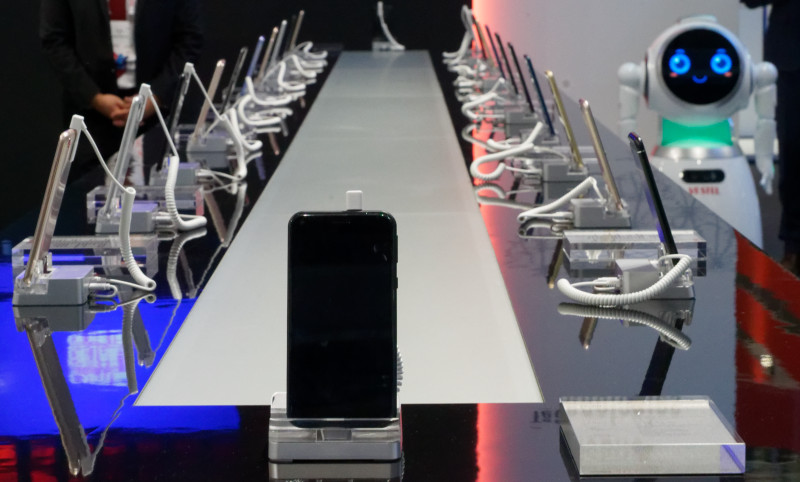 Vestel was showing the phones it sells in Turkey and a robot! Image:Meko
Vestel was showing the phones it sells in Turkey and a robot! Image:Meko
Virnect was on the Korea Telecom booth and is a developer of software and technology for AR and VR and claims 20 patents in the area. The company specialises in developing special projects and is also developing remote AR assistance software to allow. The company is working with a range of organisations including KAIST and Epson.
 Virnect has some impressive partners
Virnect has some impressive partners
Vodafone was showing a mirror-display based ‘virtual fitting room’ that is developing with fashion brand, Mango. (Vodafone and Mango Make Digital Fitting Rooms a Reality) Vodafone also announced that it would work exclusively with Samsung on IoT in some territories. “V-Home by Vodafone”, with the Samsung SmartThings Wifi hub will be launched in Spain and Germany in Q2 2018. “V-Home by Vodafone” and the Samsung SmartThings Wifi hub will be available exclusively through Vodafone stores and the Vodafone online consumer IoT marketplace in Germany, Spain and other markets to be announced in due course during 2018.
Voixatch is a start-up that was on the Korean booth in Hall 1 and has a smartwatch design that has a bezel that can be removed and used as an earphone.
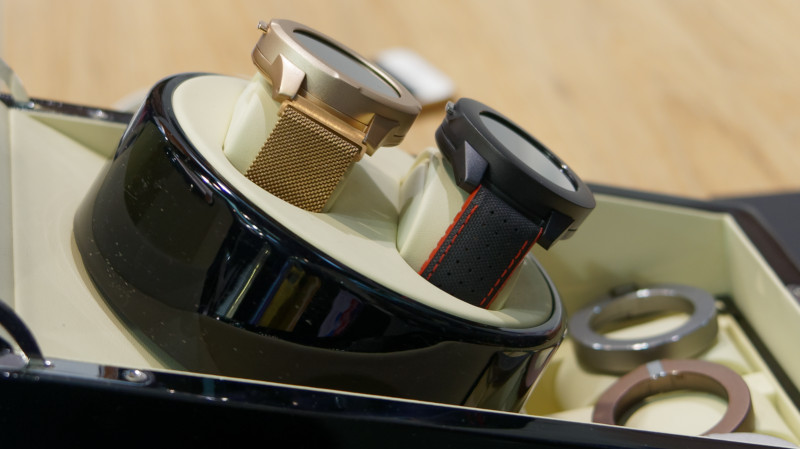 The removable bezel on the Voixatch smartwatch makes it bulky. Image:Meko
The removable bezel on the Voixatch smartwatch makes it bulky. Image:Meko
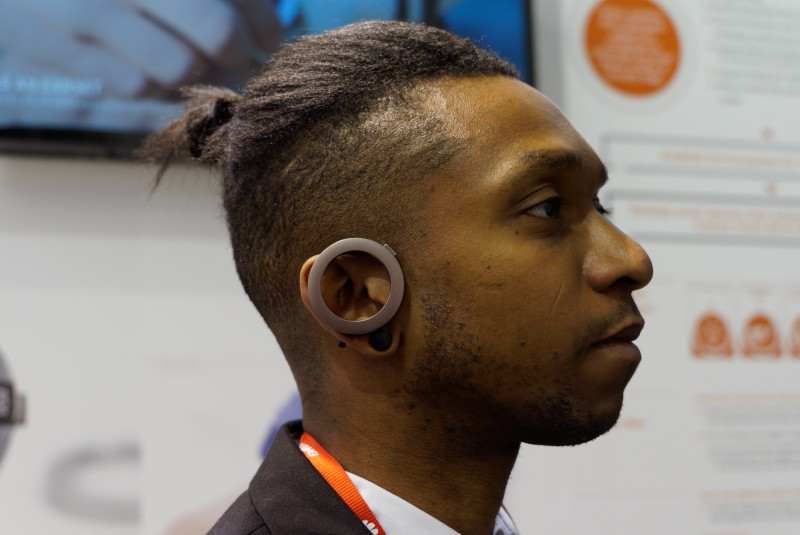 The removable bezel can be used as an earphone. Image:Meko
The removable bezel can be used as an earphone. Image:Meko
Vuzix was at the show to demonstrate its latest headsets and we had the chance to look at the latest Blade smartglasses. The glasses are a standalone unit that uses Vuzix’s own lightguide technology to process the image from the Cobra II DLP imager. The image quality looks very good indeed (480 x 854) and the technology is certainly maturing very rapidly. We were impressed with the lack of colour fringing or other artefacts on the Blade.
 The Vuzix Blade glasses use the firm’s own waveguide. Image:Meko
The Vuzix Blade glasses use the firm’s own waveguide. Image:Meko
The glasses are designed to allow prescription lenses to be fitted (an analyst who tried the glasses just before us found the lack of his prescription a problem). The company told us that around 20% of users are left eye dominant, with the majority right eye dominant. The professional version of the firm’s glasses is completely swappable, but the Blade is fixed, so the company is planning a second version with the imager on the left.
We bumped into CEO, Paul Travers, away from the firm’s booth and he said that since the impact that the company had at CES, he has had a stream of Tier 1 companies visiting the firm’s site in Rochester, New York. (MDM CES Round-up)
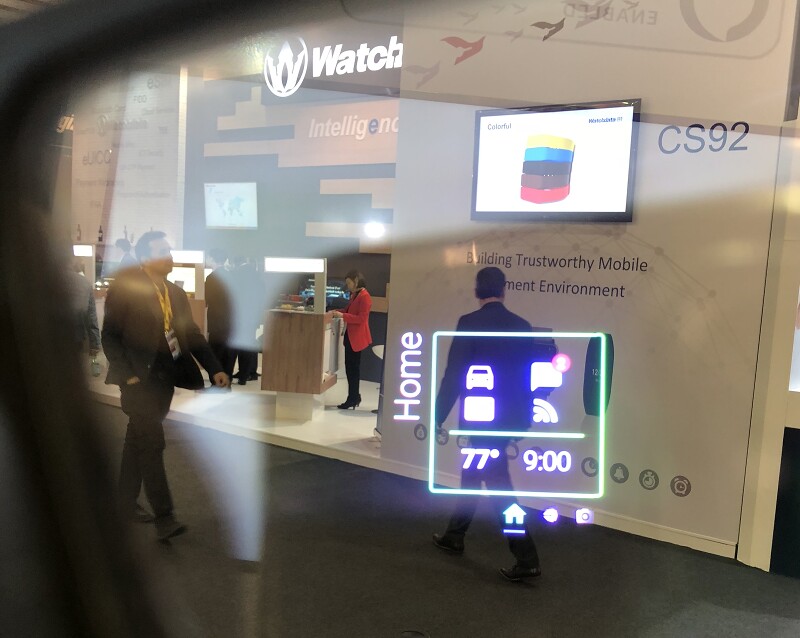 We had trouble taking a shot of the image on the Vuzix Blade with our good camera, as the camera was too bulky, so thanks to Vuzix for taking this one for us! Image:Vuzix
We had trouble taking a shot of the image on the Vuzix Blade with our good camera, as the camera was too bulky, so thanks to Vuzix for taking this one for us! Image:Vuzix
Weeview Inc (it’s a shame about the name!) was at the 4YFN event and was showing its low cost lens system for stereo viewing on mobile handsets.
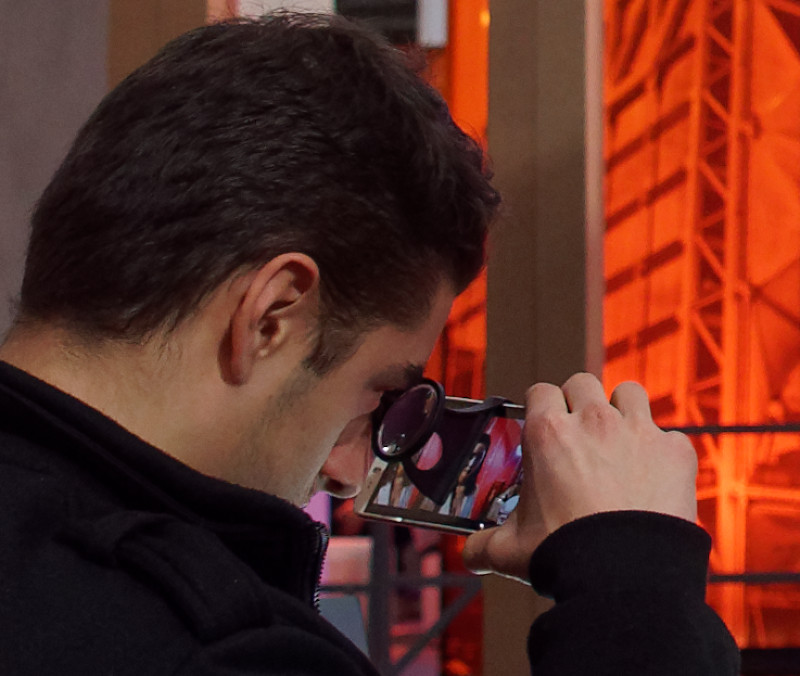 WeeView has a very basic stereo viewer. Image:Meko
WeeView has a very basic stereo viewer. Image:Meko
Xiaomi didn’t have any new smartphones (although it leaked information that the Mi Mix 2S, to be announced later this month, will use the Snapdragon 645) and was highlighting the range of products that it can supply including some good looking notebook PCs. However, the company did have a new laser phosphor UST projector designed for TV replacement and supporting diagonals of 100″ to 150″. The contrast is said to be 3,000:1 and output is 5,000 lumens. The image looked very good to us and the unit has the ‘mi TV’ platform integrated, which means support for Android TV and Chromecast. The product will start to ship in the second half of 2018.
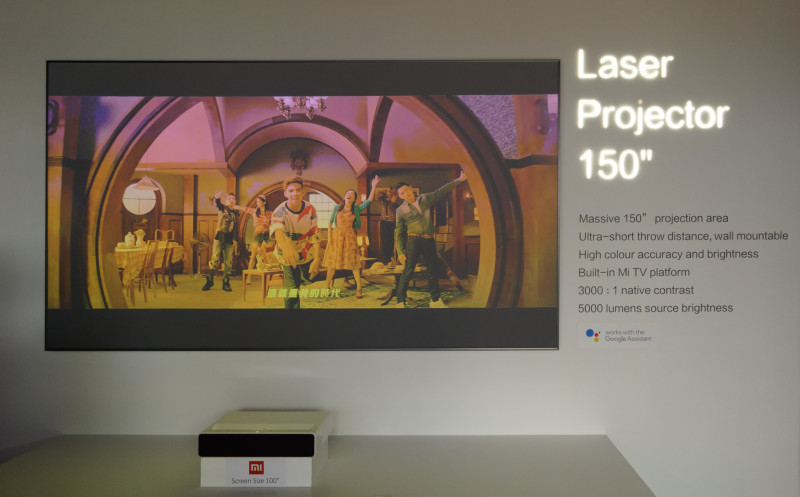 The Xiaomi projector looked good. Image:Meko
The Xiaomi projector looked good. Image:Meko

